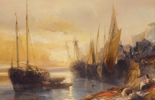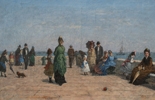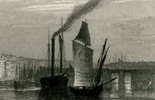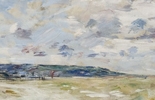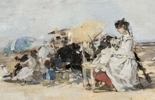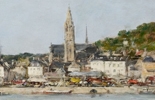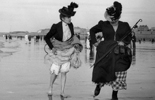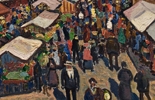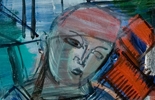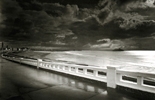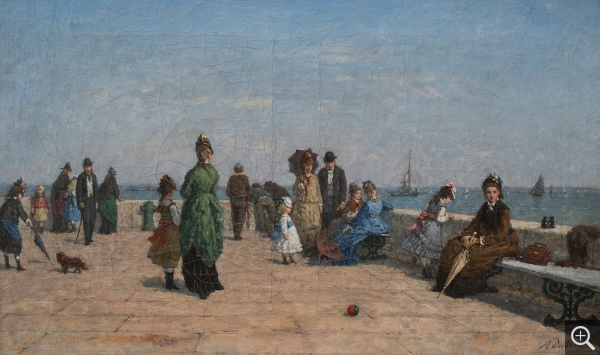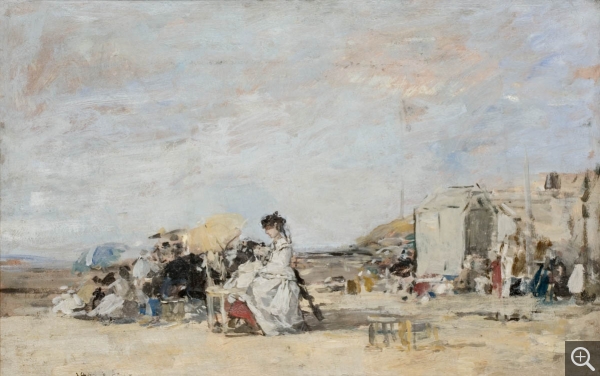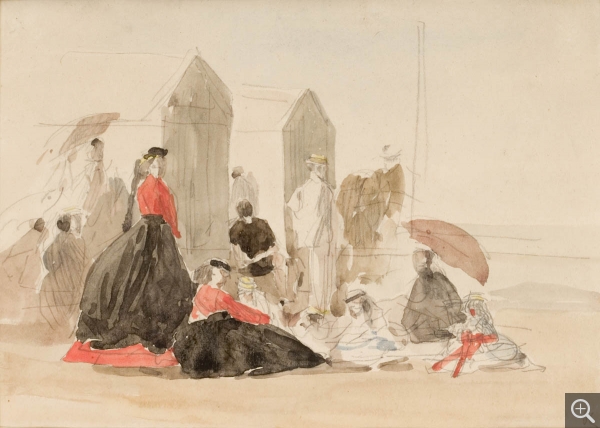L’estuaire de la Seine, l’invention d’un paysage
The English, who had already discovered the virtues of balneotherapy in the late 18th century, were the ones who started the fashion of bathing in the sea in Normandy. The trend worked its way from Dieppe, patronized by the Duchess of Berry as early as 1824, southward down the Alabaster Coast (Étretat, Sainte-Adresse) and beyond the Seine. New seaside resorts built by property developers sprung up along the Lower Normandy coast (Cabourg in 1853, Houlgate in 1854, Deauville in 1864, etc.). These posh resorts, equipped with casinos, bathhouses and racecourses, were the summer stomping grounds for the aristocracy and haute bourgeoisie of the Second Empire.
The presence of this wealthy clientele inevitably attracted artists to the Normandy coast. In 1865, Boudin, who struggled to make a start, began painting "beach scenes" that were quick to find buyers. To satisfy the increasing number of collectors, he added watercolours to his repertoire, as they were faster to produce.
During this same period, Courbet was invited to Deauville to stay with the Count of Choiseul.
Courbet was an experienced swimmer who took to the waters on a daily basis. Maupassant likened him to a seal swimming with a pipe in his mouth in all weathers. In addition to his "seascapes", he painted portraits of the "prettiest women in Trouville" and the beautiful holidaymakers, which he sold for a hefty price.
In search of a clientele, Monet followed Boudin's example and settled in Trouville in 1870, where he painted scenes of life at the resort and his wife, Camille, on the beach. The elegant women filled the paintings of Dubourg, Moullin, Corcos and Stevens, while the intrepid women bathing in the rolling ocean waves captured the attention of others. The atmosphere of the seaside resorts on the Normandy coast was later extolled in the pages of Marcel Proust's In Search of Lost Time.
The presence of this wealthy clientele inevitably attracted artists to the Normandy coast. In 1865, Boudin, who struggled to make a start, began painting "beach scenes" that were quick to find buyers. To satisfy the increasing number of collectors, he added watercolours to his repertoire, as they were faster to produce.
During this same period, Courbet was invited to Deauville to stay with the Count of Choiseul.
Courbet was an experienced swimmer who took to the waters on a daily basis. Maupassant likened him to a seal swimming with a pipe in his mouth in all weathers. In addition to his "seascapes", he painted portraits of the "prettiest women in Trouville" and the beautiful holidaymakers, which he sold for a hefty price.
In search of a clientele, Monet followed Boudin's example and settled in Trouville in 1870, where he painted scenes of life at the resort and his wife, Camille, on the beach. The elegant women filled the paintings of Dubourg, Moullin, Corcos and Stevens, while the intrepid women bathing in the rolling ocean waves captured the attention of others. The atmosphere of the seaside resorts on the Normandy coast was later extolled in the pages of Marcel Proust's In Search of Lost Time.
- Louis Alexandre DUBOURG (1821-1891), The Jetty in Honfleur, oil on canvas, 35.5 x 65.5 cm. © MuMa Le Havre / David Fogel
- Eugène BOUDIN (1824-1898), Lady in White on the Beach at Trouville, 1869, oil on board, 31.4 x 48.6 cm. © MuMa Le Havre / Florian Kleinefenn
- Eugène BOUDIN (1824-1898), Crinolines and Cabins, 1865, black pencil, graphite and watercolour on laid paper, 16.7 x 23.7 cm. © MuMa Le Havre / Charles Maslard


